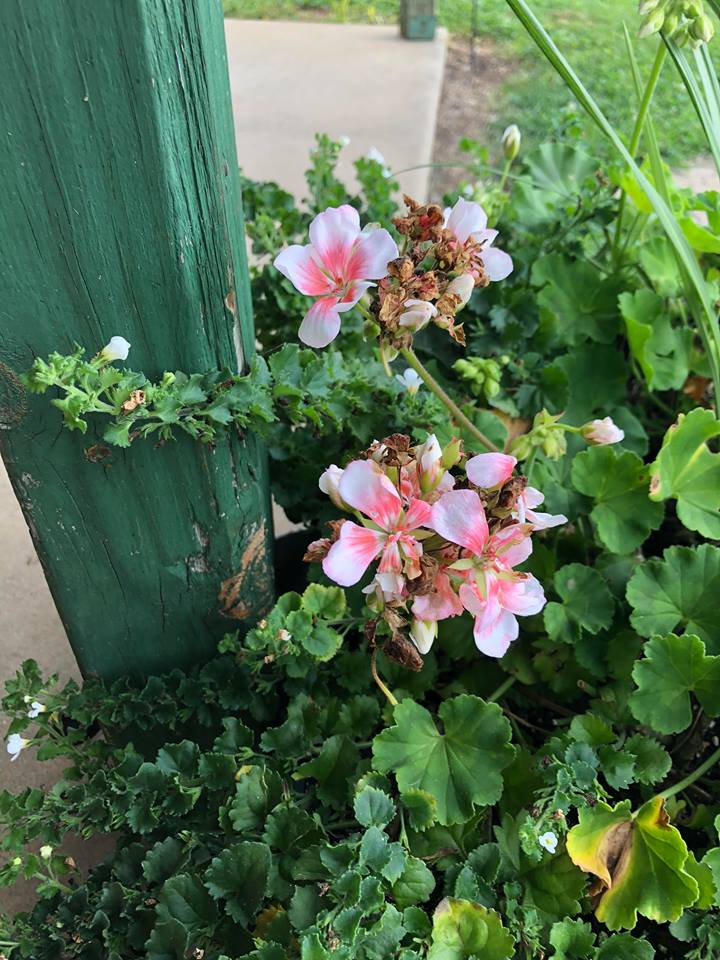Botrytis Blight: A Fungus Among Us
This past week, I got a message from Laura Brinker. She was having a problem with her geranium. It had new buds on it that were seemingly dying before even blooming! However, when she sent me a photo what caught my eye was the browning leaves near the bottom right of the photo. I had seen this before…
The ever popular geranium, is prized in the garden because of its wide variety of colorful flowers and foliage. Zonal geraniums, which are tender perennials, usually are grown as annuals and prefer moist soil. However, their preferred growing conditions make geraniums vulnerable to fungal infections, and the unseasonable wet, cool weather recently hasn’t helped matters. One of the most common fungi that attack geranium plants is botrytis blight, which is caused by the fungus botrytis cinerea.
Botrytis Blight
Botrytis, sometimes called grey mold, is spread through the air as the fine spores are lifted from the soil and carried to your geranium. Even the air caused by walking past or pruning your plant can spread botrytis spores. Botrytis fungi prefer to feed on dead or dying plant material, but if the fungus has ideal conditions for growth, it attacks living plant tissue as well. Botrytis fungi prefer cool, moist conditions. Temperatures ranging from 50 to 60 degrees Fahrenheit are ideal for its growth. Because geraniums also prefer cool, moist conditions, botrytis is a common problem for these plants.
Symptoms of Infection
Botrytis fungi prefer to feed on dead plant material, but it is hard to detect infection in the dead foliage of your geranium. However, dried leaves infected by botrytis fungus disperse a fine dust into the air when moved. These are the fungus spores. On living plant tissue, botrytis infections are indicated by fuzzy gray or brown blooms and black spots on the stems. If cool, damp conditions exist, these small black spots eat into the stem itself, consuming it entirely. On the leaves, you may see spots, lesions or large dead areas with concentric rings around them. Flowers and leaves may also begin to drop prematurely.
Cultural Control
Good sanitation practices, such as pulling weeds and keeping the soil clear of debris, are helpful in controlling botrytis blight in geraniums. Prune away infected plant parts and dispose of these in the garbage. Do not compost dead plant material infected with botrytis. Avoid watering your plants overhead. Instead, water the soil early in the day so that it has adequate time to dry before the cool evening temperatures arrive.
Chemical Control
Fungicide sprays containing chlorothalonil, copper ammonium carbonate, neem oil, potassium bicarbonate or bacillus subtilis can effectively control botrytis blight in geraniums. Apply fungicides after periods of wet weather. Fungicide sprays can contribute to moisture levels, so adequate ventilation and circulation of air around your plant are necessary to prevent further infections.
Prevention
The best way to fight botrytis infection is to prevent it from taking over your plant. Pick all dead leaves and blooms from your plant as you see them, and remove debris from the soil as well. If your geranium is growing in damp or cool conditions, thin the branches, and give plants ample space to ensure that there is enough air circulation to dry the leaves. Indoors, place your plant in an open window or near a fan to receive air that keeps the foliage and soil surface dry, and deprives the fungus of the moisture it needs to multiply.


